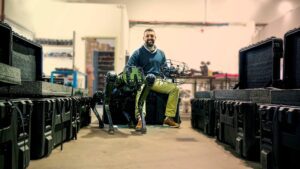Israel’s increased use of robots in Gaza allows it to surveil Palestinians without jeopardizing the lives of soldiers and dogs – while it field-tests and showcases the product for security states.
by Sagi Cohen, reposted from Ha’aretz, March 3, 2024
NOTE: Israel has long used Gaza as a testing ground for new weaponry that it later markets around the world. Avi Hasson, chief executive of Startup Nation Central, an Israeli tech incubator, recently said, “In general the war in Gaza presents threats, but also opportunities to test emerging technologies in the field.”
In an effort to avoid harming soldiers and dogs, the IDF has been experimenting with the use of robots and remote-controlled dogs in the Gaza War. Most of the tests have been with a “robot dog,” which is also equipped with a drone and can replace or reinforce the Oketz Unit’s dogs in certain situations. Unmanned remote-control D9 bulldozers are also being used.
It is nothing new for the IDF to use robots and unmanned ground vehicles, especially by elite units and the Yahalom Unit operating in the tunnels. However, there have also been unsuccessful projects. The October 7 attack, which showed starkly that it is not possible to rely solely on technology, strengthened doubts about these developments. But defense establishment officials confirm that there has been a leap in the use and sophistication of robots on the battlefield.
A prominent example is the procurement of Vision 60 units, a dog-shaped walking robot made by Philadelphia-based Ghost Robotics. The first four units entered military service during the war, financed by donors. The defense establishment subsequently procured more units. Another robot, called the Rooster, is installed on the robot’s back, creating a kind of ground robot and drone, jointly developed by Israeli startup Robotican and the Defense Research & Development Directorate.

The robots’ integration is the result of the recently announced collaboration between Ghost Robotics and Robotican , which was founded in 2013 and currently operates with no external financing and has about 40 employees. Robotican is an importer that also equips the robot with a software platform and specific autonomous capabilities.
The robot’s primary use is for initial surveillance of buildings, open spaces and tunnels to verify that there are no IEDs or terrorists in them, without jeopardizing Oketz Unit soldiers and dogs. The robot dogs have taken “casualties” to date: a number of have been damaged or destroyed.
The robot dogs have some advantages over real dogs; they include numerous sensors and a more stable filming platform compared with cameras carried by dogs. According to a report in The Wall Street Journal in December, Israel has begun using the robots in tunnels, partly because the ground is full of garbage and obstacles that hinder the progress of other robots in use by the IDF.

According to the Ghost Robotics website, the robot dog is equipped with sensors and a system that enables it to operate in an unknown environment and recover and get up after falling or slipping. It can walk for up to a distance of 10 kilometers at a speed of three meters per second, and can work for up to three hours. If necessary, the Rooster robot, installed on the Vision 60’s back, comes into use.

The Rooster is a drone inside a wheeled cage, so it can be move over the ground on wheels, but, if necessary, can also “jump” and fly over obstacles and steps and go through windows.
“The objective is to enter before the soldiers and identify traps and other hazards,” explains Robotican CEO Hagai Balshai. “This robot has been in use for several years, but because of the characteristics of urban and underground warfare, it has made a significant leap forward.”
Naturally, the robot dog also has disadvantages, including less transit capability than canines and limitations such as the communications range. According to The Wall Street Journal, other disadvantages are its weight (51 kilograms), which makes it difficult to bring to the field, and its high price: $150,000 per unit.
The Vision 60 and Rooster are joining the IDF’s massive use of drones in the Gaza Strip for both attack and surveillance of buildings and photographing space before soldiers enter them. The IDF has also expanded its use of remote-controlled vehicles. A few years ago, the Defense Research & Development Directorate launched the “Iron Animal” project to jointly develop a kit with defense contractors to create remote-controlled vehicles; i.e. semi-autonomous.
For the first time, the Panda, the remote-controlled D9 bulldozer, jointly developed by Israel Aerospace Industries subsidiary Elta Systems, the IDF Ground Forces Technology Division and the Defense Research & Development Directorate, has been used in the Gaza war. The D9 is remotely operated by a screen and joystick to carry out missions to expose ground and demolish buildings without jeopardizing soldiers.
NOTE: During the current incursion, Israel has reportedly been using military bulldozers to crush Palestinians.
RELATED READING:
- Israel is selling arms to fellow human rights abusers, including Myanmar
- Thanks to Gaza protests, Israel has a new crop of ‘battle tested’ weapons for sale
- Israel lobby has helped make US obsolete by enabling Israel to be a top arms exporter
- Video and new database expose decades of Israel’s shady arms deals





